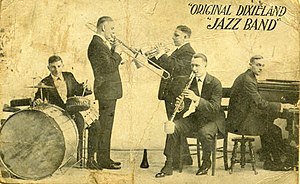List of pre-1920 jazz standards
This list includes compositions written before 1920 that are considered standards by at least one major fake book publication or reference work.
From its conception at the change of the twentieth century, jazz was music intended for dancing.
This influenced the choice of material played by early jazz groups: King Oliver's Creole Jazz Band, New Orleans Rhythm Kings and others included many Tin Pan Alley popular songs in their repertoire, and record companies often used their power to dictate which songs were to be recorded by their artists.
Tin Pan Alley songwriters contributed several songs to the jazz standard repertoire, including "Indiana" and "After You've Gone".
The most often recorded standards of this period are W. C. Handy's "St. Louis Blues", Turner Layton and Henry Creamer's "After You've Gone" and James Hanley and Ballard MacDonald's "Indiana".




